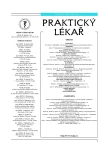-
Medical journals
- Career
The immunopathogenesis of atherosclerosis: C-reactive protein, complement, and regulatory proteins
Authors: P. Kuneš
Authors‘ workplace: Kardiochirurgická klinika FN a LF UK, Hradec Králové přednosta prof. MUDr. J. Dominik, CSc.
Published in: Prakt. Lék. 2005; 85(1): 4-9
Category: Reviews
Overview
Chronic inflammatory reactions which affect the arterial wall can be viewed as an underlying cause of atherosclerosis. C-reactive protein is an easily measurable marker which reflects the activity of inflammatory responses. At the same time, CRP represents an active partaker of the inflammatory process. The role CRP plays in the pathogenesis of atherosclerosis is ambivalent: at the very beginning, it displays anti-inflammatory properties which contribute to the protection of the arterial wall from atherogenic lipoproteins. Later on, genetic disposition of the host and the influence of many known risk factors convert CRP’s antiinflammatory activity into a net pro-inflammatory effect which boosts the development of atherosclerosis.
Both the protective anti-inflammatory and the noxious pro-inflammatory activities of CRP reside in its capacity to activate the complement cascade. The protective effect of CRP, which is dependent on the plasmatic regulatory factor H, is carried out by the activation of complement up to the level of fragments C3b/iC3b. Further, CRP directly induces production of the complement membrane regulatory proteins, most important of which is the decay-accelerating factor. Membrane regulatory factors form an integral part of the outer cellular membrane, most importantly that of endothelial cells, resulting in protection of the latter from autodestructive attacks inflicted by activated complement. One of the complement regulatory factors is represented by clusterin/apolipoproteinJ. However, according to recent studies, clusterin/apoJ belongs rather to a group of stress proteins, which display overall protective effects on cellular protein structures. Protective activities of CRP based on its cooperation with complement regulatory factors are closely mimicked by the HMG-CoA reductase inhibitors or statins.Key words:
atherosclerosis – C-reactive protein – complement – regulatory factors – statins.
Labels
General practitioner for children and adolescents General practitioner for adults
Article was published inGeneral Practitioner

2005 Issue 1-
All articles in this issue
- The immunopathogenesis of atherosclerosis: C-reactive protein, complement, and regulatory proteins
- Atopic dermatitis – also a psychoneurological problem
- Auricular fibrillation in everyday practice
- Lithiasis in otorhinolaryngology
- Treatment of primary anorgasmia
- Responsiveness is one of the important objectives and criteria of quality in healthcare
- Lesion of the cervical lymphatic drainage in repeated operations on the thyroid gland for cancer
- Multiple osteolytic foci – a differential diagnostic approach (case report)
- Several notes on the current treatment of obstructive jaundice
- Current possibilities of the application of transfusion products and blood derivatives in serious disorders of hemocoagulation
- Abused child syndrome
- General Practitioner
- Journal archive
- Current issue
- Online only
- About the journal
Most read in this issue- Multiple osteolytic foci – a differential diagnostic approach (case report)
- Treatment of primary anorgasmia
- Lithiasis in otorhinolaryngology
- Abused child syndrome
Login#ADS_BOTTOM_SCRIPTS#Forgotten passwordEnter the email address that you registered with. We will send you instructions on how to set a new password.
- Career

